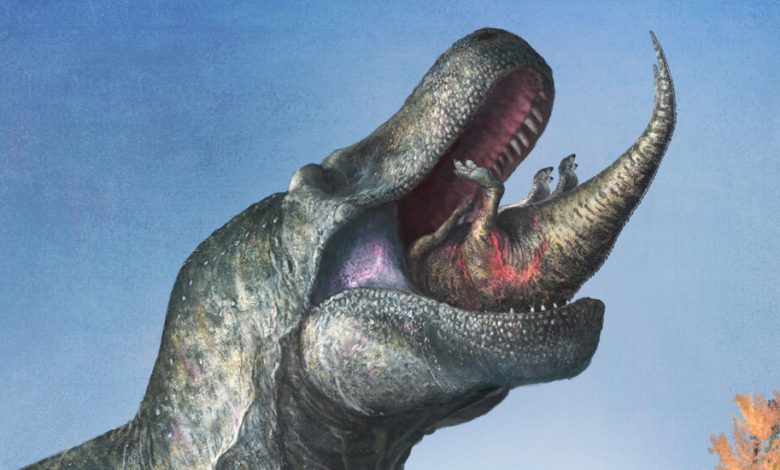Imagine T. Rex. Now Imagine It With Lips.

Brimming with serrated teeth bigger than bananas, Tyrannosaurus rex’s fanged maw is iconic. Many depictions of the prehistoric predator show its teeth sticking out even when its mouth is closed, like a snaggletoothed crocodile.
However, some paleontologists think T. rexes need some serious lip filler. In a study published Thursday in Science, researchers posit that Tyrannosaurs and related dinosaurs kept their dagger-like dentition hidden behind lip-like tissue. And while some critics are giving them lip about it, the study’s authors say it’s time we rethink what the apex dinosaur’s mouth looked like as it tore into prey.
While birds are the closest living relatives to theropod dinosaurs, the group that included mega predators like T. rex, their specialized beaks tell scientists little about dinosaur mouths. So researchers have often turned to crocodiles, whose exposed teeth poke directly out of the jaw with no lip-like tissue covering them. Even when a crocodile’s jaws are shut, its teeth are visible.
This has led many scientists and artists to depict lipless dinosaurs with their chompers constantly on display. One of the most influential depictions is the Tyrannosaurus from “Jurassic Park.”
“That animal has been copied so many times,” said Mark Witton, a paleoartist and researcher at the University of Portsmouth in England who has been illustrating lipped theropods for around a decade. “It carried that lipless look into pop culture to the point where we’re now struggling to get rid of it.”
Dr. Witton is among the scientists and paleoartists who have argued that theropods had a fleshy area surrounding their mouths. He and other colleagues recently teamed up to seek fossil evidence of these fuller lips.
They focused on the teeth. According to the researchers, many theropods’ teeth were encased in a thin layer of enamel. The researchers hypothesized that constant exposure to air could make the enamel brittle and prone to splintering. Lipless crocodilians, for example, wear down teeth at an accelerated pace — an American alligator can go through 3,000 teeth in its lifetime. In contrast, Tyrannosaurs and other theropods tended to hang onto their teeth much longer.
To compare the wear patterns between crocodilians and theropods, the team studied thin cross sections of teeth from an American alligator and a Daspletosaurus, a close T. rex relative. They found that the enamel on the outer, exposed side of the alligator’s tooth was often more eroded than the tooth’s inner portion.
“We don’t see that pattern at all in Tyrannosaurs,” said Thomas Cullen, a paleontologist at Auburn University and one of the paper’s authors.
The wear on the Daspletosaurus tooth was different, a sign, they said, that a lip-like covering protected it from drying out.
“In our Tyrannosaur sample, we see even enamel thickness on both the inside and outside of the tooth which is more similar to what we see in animals that do have lips,” Dr. Cullen said.
The team also examined the skulls of Komodo dragons and other monitor lizards. These reptiles have blade-like teeth reminiscent of theropod teeth, which they keep moist under scaly lips. While monitor lizards are only distantly related to theropods, the team found the relationship between skull and tooth size was similar. That likeness dispels any notions that the largest carnivorous dinosaurs would have trouble fitting their teeth under their lips, they said.
But not all paleontologists are sold on theropod lips.
Thomas Carr, a paleontologist at Carthage College in Wisconsin, said the researchers did not account for the bone texture of Tyrannosaur skulls, which resembled the leathery texture of an alligator skull right down to where the teeth are embedded into the jaw. He also argued that the dentin of Tyrannosaur teeth was more significant than the enamel. “That’s the tissue that I think is arguably structurally more important to a Tyrannosaur because if the dentin shatters, then they’ll be eating bananas,” Dr. Carr said. As a result, he thinks keeping the enamel moist under lips was not essential for maintaining teeth strong enough to bite through bone.
The only thing that could drive the dinosaur lip debate to extinction may be a fossilized face. “We won’t have a firm answer unless we find a really rare example of a theropod with soft tissues of the face preserved intact,” Dr. Cullen said. “It is not impossible — it just hasn’t happened yet.”